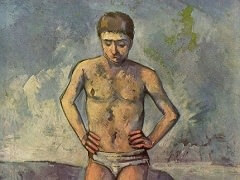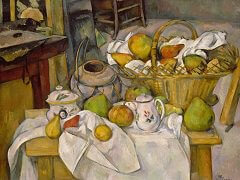The Black Marble Clock, 1869 - by Paul Cezanne

By the end of the 1860s, the need for carefully considered, nuanced painting - decisions made stroke by stroke - was already part of Cezanne's nature. Much in his later still lifes - their composition and serious mood - may be found in this canvas. It is astonishing to see how the young Cezanne is able to combine the finesse of tones separated by tiny intervals of brightness and hue with bold contrasts in the large areas and lines. The dominant white-grey-black pointed up with sharp yellow and red, and the breadth and virility of touch, recall Manet. The conception of the still life is also like Manet's in such elements as the chocolate cup and saucer, the lemon, and the ormolu clock - objects of piquant taste and shiny texture. But the profusion of things, the varied execution, in places thick and rough, elsewhere thin and transparent, and, above all, the monstrosity of the shell, reflect another temperament - more intense, involved, and ungainly. Like Manet, Cezanne turned to still life as a subject matter inciting contemplation of contrasts and harmonies latent in the neighborliness of different silent objects touched by the same light. Manet savored the objects, distilling their essences of texture and light (and even of taste and fragrance) with a magically sure brush; while Cezanne, a more gravely contemplative mind, studied them as the model of a complete world, a semblance of both nature and man, in which order and freedom, regularity and chance, could be made visible throughout. But at t his point in his career, feeling is important in his choice of things to paint; there are, we sense, vague fancies behind the clock without hands and the huge sea shell with reddened gaping mouth. Twenty years later, he will place a plaster Cupid among the fruit, and still later a human skull.
The shell is the most richly colored and organic-looking object of all and stands out against the severity of the neighboring lines. There is a baroque exuberance in its upper edge, and we see its influence in the scalloped vertical band behind it and in the contrasted zigzag mouth of the glass vase as well as in the billowing rumpled cloth at the right.
The beauty of this little painting - it is a surprise to see how small it is - lies especially in the play of dark and light, not simply as light and shadow but as a harmony of tones concentrated at the black and white ends, with the most delicate variations of cool and warm. The zone of middle values is less rich. To the scale of light and dark values corresponds the scale of opposed verticals and horizontals tempered by the few curves. The varying lengths, intervals, and colors of these straight forms are finely conceived. The rhythm is clearest in the table cloth with its spacing of folds in progressively broader bands and changing contrast of shadow and light. The whites of the cloth are picked up and varied in the objects above; and its darker accents reappear within the same objects and the background. Each of the still life pieces is wonderfully painted and deserves the closest scrutiny as an original little world of color, light, form, and the painter's touch.














